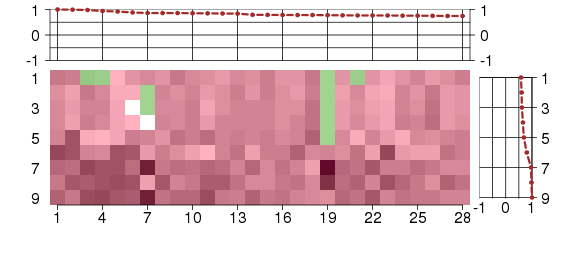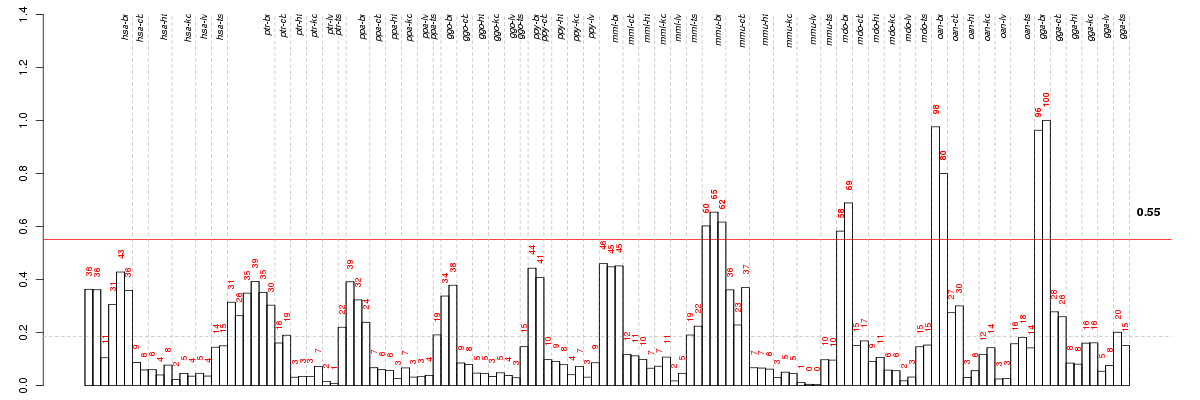



Under-expression is coded with green,
over-expression with red color.


plasma membrane
The membrane surrounding a cell that separates the cell from its external environment. It consists of a phospholipid bilayer and associated proteins.
membrane
Double layer of lipid molecules that encloses all cells, and, in eukaryotes, many organelles; may be a single or double lipid bilayer; also includes associated proteins.
integral to membrane
Penetrating at least one phospholipid bilayer of a membrane. May also refer to the state of being buried in the bilayer with no exposure outside the bilayer. When used to describe a protein, indicates that all or part of the peptide sequence is embedded in the membrane.
integral to plasma membrane
Penetrating at least one phospholipid bilayer of a plasma membrane. May also refer to the state of being buried in the bilayer with no exposure outside the bilayer.
cellular_component
The part of a cell or its extracellular environment in which a gene product is located. A gene product may be located in one or more parts of a cell and its location may be as specific as a particular macromolecular complex, that is, a stable, persistent association of macromolecules that function together.
cell
The basic structural and functional unit of all organisms. Includes the plasma membrane and any external encapsulating structures such as the cell wall and cell envelope.
intrinsic to membrane
Located in a membrane such that some covalently attached portion of the gene product, for example part of a peptide sequence or some other covalently attached moiety such as a GPI anchor, spans or is embedded in one or both leaflets of the membrane.
intrinsic to plasma membrane
Located in the plasma membrane such that some covalently attached portion of the gene product, for example part of a peptide sequence or some other covalently attached moiety such as a GPI anchor, spans or is embedded in one or both leaflets of the membrane.
macromolecular complex
A stable assembly of two or more macromolecules, i.e. proteins, nucleic acids, carbohydrates or lipids, in which the constituent parts function together.
ion channel complex
A protein complex that spans a membrane and forms a water-filled channel across the phospholipid bilayer allowing selective ion transport down its electrochemical gradient.
cation channel complex
An ion channel complex through which cations pass.
protein complex
Any macromolecular complex composed of two or more polypeptide subunits, which may or may not be identical. Protein complexes may have other associated non-protein prosthetic groups, such as nucleotides, metal ions or other small molecules.
membrane part
Any constituent part of a membrane, a double layer of lipid molecules that encloses all cells, and, in eukaryotes, many organelles; may be a single or double lipid bilayer; also includes associated proteins.
plasma membrane part
Any constituent part of the plasma membrane, the membrane surrounding a cell that separates the cell from its external environment. It consists of a phospholipid bilayer and associated proteins.
cell part
Any constituent part of a cell, the basic structural and functional unit of all organisms.
all
NA
cell part
Any constituent part of a cell, the basic structural and functional unit of all organisms.
membrane part
Any constituent part of a membrane, a double layer of lipid molecules that encloses all cells, and, in eukaryotes, many organelles; may be a single or double lipid bilayer; also includes associated proteins.
ion channel complex
A protein complex that spans a membrane and forms a water-filled channel across the phospholipid bilayer allowing selective ion transport down its electrochemical gradient.
plasma membrane part
Any constituent part of the plasma membrane, the membrane surrounding a cell that separates the cell from its external environment. It consists of a phospholipid bilayer and associated proteins.
intrinsic to plasma membrane
Located in the plasma membrane such that some covalently attached portion of the gene product, for example part of a peptide sequence or some other covalently attached moiety such as a GPI anchor, spans or is embedded in one or both leaflets of the membrane.
ion channel complex
A protein complex that spans a membrane and forms a water-filled channel across the phospholipid bilayer allowing selective ion transport down its electrochemical gradient.
integral to plasma membrane
Penetrating at least one phospholipid bilayer of a plasma membrane. May also refer to the state of being buried in the bilayer with no exposure outside the bilayer.

peptide receptor activity
Combining with an extracellular or intracellular peptide to initiate a change in cell activity.
molecular_function
Elemental activities, such as catalysis or binding, describing the actions of a gene product at the molecular level. A given gene product may exhibit one or more molecular functions.
signal transducer activity
Mediates the transfer of a signal from the outside to the inside of a cell by means other than the introduction of the signal molecule itself into the cell.
receptor activity
Combining with an extracellular or intracellular messenger to initiate a change in cell activity.
transmembrane receptor activity
Combining with an extracellular or intracellular messenger to initiate a change in cell activity, and spanning to the membrane of either the cell or an organelle.
G-protein coupled receptor activity
A receptor that binds an extracellular ligand and transmits the signal to a heterotrimeric G-protein complex. These receptors are characteristically seven-transmembrane receptors and are made up of hetero- or homodimers.
serotonin receptor activity
Combining with the biogenic amine serotonin, a neurotransmitter and hormone found in vertebrates, invertebrates and plants, to initiate a change in cell activity.
binding
The selective, non-covalent, often stoichiometric, interaction of a molecule with one or more specific sites on another molecule.
neuropeptide receptor activity
Combining with a neuropeptide to initiate a change in cell activity.
G-protein coupled amine receptor activity
A receptor that binds an extracellular amine and transmits the signal to a heterotrimeric G-protein complex. These receptors are characteristically seven-transmembrane receptors and are made up of hetero- or homodimers.
peptide receptor activity, G-protein coupled
Combining with an extracellular or intracellular peptide to initiate a G-protein mediated change in cell activity. A G-protein is a signal transduction molecule that alternates between an inactive GDP-bound and an active GTP-bound state.
neurotransmitter receptor activity
Combining with a neurotransmitter to initiate a change in cell activity.
neurotransmitter binding
Interacting selectively and non-covalently with a neurotransmitter, any chemical substance that is capable of transmitting (or inhibiting the transmission of) a nerve impulse from a neuron to another cell.
peptide binding
Interacting selectively and non-covalently with peptides, any of a group of organic compounds comprising two or more amino acids linked by peptide bonds.
neuropeptide binding
Interacting selectively and non-covalently and stoichiometrically with neuropeptides, peptides with direct synaptic effects (peptide neurotransmitters) or indirect modulatory effects on the nervous system (peptide neuromodulators).
molecular transducer activity
The molecular function that accepts an input of one form and creates an output of a different form.
all
NA
neuropeptide receptor activity
Combining with a neuropeptide to initiate a change in cell activity.
peptide receptor activity
Combining with an extracellular or intracellular peptide to initiate a change in cell activity.
neurotransmitter receptor activity
Combining with a neurotransmitter to initiate a change in cell activity.
neuropeptide receptor activity
Combining with a neuropeptide to initiate a change in cell activity.
peptide receptor activity, G-protein coupled
Combining with an extracellular or intracellular peptide to initiate a G-protein mediated change in cell activity. A G-protein is a signal transduction molecule that alternates between an inactive GDP-bound and an active GTP-bound state.
| Id | Pvalue | ExpCount | Count | Size | Term |
|---|---|---|---|---|---|
| 04080 | 3.138e-02 | 0.4922 | 4 | 102 | Neuroactive ligand-receptor interaction |
BCL11BB-cell CLL/lymphoma 11B (zinc finger protein) (ENSG00000127152), score: 0.85 BMP3bone morphogenetic protein 3 (ENSG00000152785), score: 0.78 BRS3bombesin-like receptor 3 (ENSG00000102239), score: 0.86 C8orf34chromosome 8 open reading frame 34 (ENSG00000165084), score: 0.78 CNTN5contactin 5 (ENSG00000149972), score: 0.77 COL25A1collagen, type XXV, alpha 1 (ENSG00000188517), score: 0.79 DLX6distal-less homeobox 6 (ENSG00000006377), score: 0.76 EPHA5EPH receptor A5 (ENSG00000145242), score: 0.78 FIBCD1fibrinogen C domain containing 1 (ENSG00000130720), score: 0.84 GPR139G protein-coupled receptor 139 (ENSG00000180269), score: 0.99 HTR1D5-hydroxytryptamine (serotonin) receptor 1D (ENSG00000179546), score: 0.77 HTR45-hydroxytryptamine (serotonin) receptor 4 (ENSG00000164270), score: 0.85 IL1RAPL1interleukin 1 receptor accessory protein-like 1 (ENSG00000169306), score: 0.75 IL1RAPL2interleukin 1 receptor accessory protein-like 2 (ENSG00000189108), score: 0.92 KCNA4potassium voltage-gated channel, shaker-related subfamily, member 4 (ENSG00000182255), score: 0.75 KCNK2potassium channel, subfamily K, member 2 (ENSG00000082482), score: 0.75 KCNS2potassium voltage-gated channel, delayed-rectifier, subfamily S, member 2 (ENSG00000156486), score: 0.77 LRRC7leucine rich repeat containing 7 (ENSG00000033122), score: 0.86 NPY2Rneuropeptide Y receptor Y2 (ENSG00000185149), score: 0.98 NTSneurotensin (ENSG00000133636), score: 1 OLIG3oligodendrocyte transcription factor 3 (ENSG00000177468), score: 0.78 OTOFotoferlin (ENSG00000115155), score: 0.76 SEMA3Asema domain, immunoglobulin domain (Ig), short basic domain, secreted, (semaphorin) 3A (ENSG00000075213), score: 0.79 SLC5A7solute carrier family 5 (choline transporter), member 7 (ENSG00000115665), score: 0.94 SV2Csynaptic vesicle glycoprotein 2C (ENSG00000122012), score: 0.77 TAC1tachykinin, precursor 1 (ENSG00000006128), score: 0.86 TFAP2Dtranscription factor AP-2 delta (activating enhancer binding protein 2 delta) (ENSG00000008197), score: 0.88 TRPC5transient receptor potential cation channel, subfamily C, member 5 (ENSG00000072315), score: 0.84
| Id | species | tissue | sex | individual |
|---|---|---|---|---|
| mdo_br_m_ca1 | mdo | br | m | _ |
| mmu_br_m2_ca1 | mmu | br | m | 2 |
| mmu_br_f_ca1 | mmu | br | f | _ |
| mmu_br_m1_ca1 | mmu | br | m | 1 |
| mdo_br_f_ca1 | mdo | br | f | _ |
| oan_br_f_ca1 | oan | br | f | _ |
| gga_br_m_ca1 | gga | br | m | _ |
| oan_br_m_ca1 | oan | br | m | _ |
| gga_br_f_ca1 | gga | br | f | _ |
